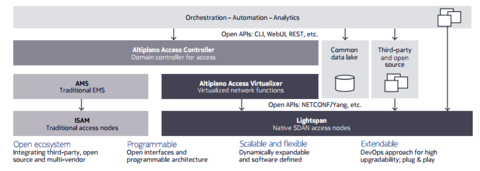Nokia is making its own mark in the emerging virtualized last mile access segment by introducing its two-part Software-Defined Access Network (SDAN) software and hardware solution sets.
As a cloud-native software platform, Altiplano is the virtualized access platform that is focused on automating the fixed access network. Altiplano’s architecture is composed of microservices that run inside lightweight Docker containers.
Service providers can install, upgrade, and elastically scale each microservice independently. Containers offer adaptability for deployment on a virtual machine (VM) or a private or public cloud. The cloud-native product centralizes and virtualized network functionality that is embedded in access equipment.
The virtualized access platform consists of two products: the Altiplano Access Controller and the Altiplano Access Virtualizer. These platforms can manage abstraction levels to enable programmability and automation.
RELATED: AT&T releases VOLTHA into the ONF community, drives focus on cloud-based XGS-PON
By creating a virtualized and centralized view of the network, Access Virtualizer provides logic and primitives that enables service providers to program and monitor hundreds of thousands of nodes through unified APIs that support multivendor YANG models as defined by the Broadband Forum. Meanwhile, the Access Virtualizer virtualizes functionality that has traditionally been embedded in the access node and addresses node reach and scale.

"We deliberately go for an open, standardized, vendor-agnostic approach that smoothly integrates legacy as well as new cloud services,” said Federico Guillén, president of Nokia Fixed Networks, in a release. “Our fixed access virtualization portfolio now covers copper, fiber, coax networks and professional services, which makes us ideally placed to transform the operator's network, operations, and business just as the opportunities of 5G begin to accelerate."
Multi-service hardware support
As the hardware element of the new SDAN solution set, Nokia’s Lightspan family can support an array of access technologies, including 5G, Gfast, and NG-PON. The platform features the Lightspan SX-16F, a 16-port reverse-powered G.fast micro-node which can be reverse-powered from the home. It also includes the Lightspan CF-24W, a stackable software-defined optical line terminal (OLT).
The Nokia Lightspan family delivers programmable access nodes, specifically designed for SDAN use cases, which bring data center practices to the central office and introduce cloud and operational agility to the copper/fiber outside plant.
The Lightspan platform features the Lightspan SX-16F, a 16-port reverse-powered G.fast micro-node which can be safely reverse-powered from the home. It also includes the Lightspan CF-24W, a stackable software-defined optical line terminal (OLT) that delivers high NG-PON capacity in a single one-rack unit.
CF-24W provides 240 Gb/s of non-blocking capacity through 24 NG-PON ports, and connects 300 Gbps redundant uplink capacity to an external leaf-spine switching fabric.
Automating FTTH
One of the use cases the Lightspan solution can satisfy is helping to automate the activation of optical network terminals (ONTs) in a FTTH network. As a result, a service provider like AT&T or CenturyLink could reduce activation costs, accelerate time to market, and improve quality of service by activating ONTs by following a simple process on a smartphone or PC.
Nokia’s timing for SDAN and the related Lightspan and Altiplano platforms could not be better, particularly as service providers look to virtualize more functions of their last mile networks.
AT&T, for one, recently put VOLTHA 1.0 (Virtual Optical Line Termination Hardware Abstraction) software-defined access specification into the Open Networking Foundation (ONF), giving it and other service providers a framework to have XGS-PON access in the cloud.
VOLTHA is the first open source software release that provides the “brain” for XGS-PON technology. It also reflects AT&T’s move toward open source software and SDN/NFV frameworks.
